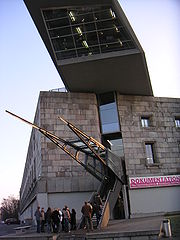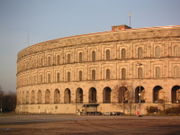
Documentation Center Nazi Party Rally Grounds
Encyclopedia


German language
German is a West Germanic language, related to and classified alongside English and Dutch. With an estimated 90 – 98 million native speakers, German is one of the world's major languages and is the most widely-spoken first language in the European Union....
: Dokumentationszentrum Reichsparteitagsgelände) is a museum in Nuremberg
Nuremberg
Nuremberg[p] is a city in the German state of Bavaria, in the administrative region of Middle Franconia. Situated on the Pegnitz river and the Rhine–Main–Danube Canal, it is located about north of Munich and is Franconia's largest city. The population is 505,664...
. It is in the north wing of the unfinished remains of the Congress Hall of the former Nazi party rallies. Its permanent exhibition "Fascination and Terror" is concerned with the causes, connections, and consequences of Nazi Germany
Nazi Germany
Nazi Germany , also known as the Third Reich , but officially called German Reich from 1933 to 1943 and Greater German Reich from 26 June 1943 onward, is the name commonly used to refer to the state of Germany from 1933 to 1945, when it was a totalitarian dictatorship ruled by...
. Topics that have a direct reference to Nuremberg are especially taken into account. Attached to the museum is an education forum.
Architecture
In 1994 the city council of Nuremberg decided to establish the Documentation Center. Austrian architect Günther DomenigGünther Domenig
Günther Domenig is an Austrian architect.Domenig studied architecture at the Technische Universität, Graz , and after working as an architectural assistant, set up in practice with Eilfried Huth , producing highly regarded buildings in a brutalist vein...
designed the museum, winning the 1998 international competition with his proposal to spear through the northern head of the building with a diagonal glass and steel passageway. Inherent in the gesture of this project is a pun on the name and a refutation of the chief Nazi architect Albert Speer
Albert Speer
Albert Speer, born Berthold Konrad Hermann Albert Speer, was a German architect who was, for a part of World War II, Minister of Armaments and War Production for the Third Reich. Speer was Adolf Hitler's chief architect before assuming ministerial office...
who had directed a masterplan for this site including a Zeppelin Field, a stadium to hold 400,000, a March Field for military exercises, a Congress Hall for 50,000, and a 180 feet (54.9 m) wide Great Road. This is where Speer had created the "cathedral of light" and where the Nazis drew nearly a million people in rallies between 1933 an 1938. These were captured on film by Leni Riefenstahl
Leni Riefenstahl
Helene Bertha Amalie "Leni" Riefenstahl was a German film director, actress and dancer widely noted for her aesthetics and innovations as a filmmaker. Her most famous film was Triumph des Willens , a propaganda film made at the 1934 Nuremberg congress of the Nazi Party...
in Triumph of the Will
Triumph of the Will
Triumph of the Will is a propaganda film made by Leni Riefenstahl. It chronicles the 1934 Nazi Party Congress in Nuremberg, which was attended by more than 700,000 Nazi supporters. The film contains excerpts from speeches given by various Nazi leaders at the Congress, including portions of...
. Domenig, the son of a Nazi judge, confronted his own personal history in addition to the history and Nazi architecture
Nazi architecture
Nazi architecture was an architectural plan which played a role in the Nazi party's plans to create a cultural and spiritual rebirth in Germany as part of the Third Reich....
of the project's site. On November 4, 2001 the project was unveiled by Johannes Rau
Johannes Rau
Johannes Rau was a German politician of the SPD. He was President of Germany from 1 July 1999 until 30 June 2004, and Minister-President of North Rhine-Westphalia from 1978 to 1998.-Education and work:...
, then President of Germany
President of Germany
The President of the Federal Republic of Germany is the country's head of state. His official title in German is Bundespräsident . Germany has a parliamentary system of government and so the position of President is largely ceremonial...
.
Exhibition
The permanent exhibition "Fascination and Terror" (Faszination und Gewalt) studies the causes, coherence, and consequences of National Socialism. It describes the Nazi Party Rallies and explains the fascination they exercised upon participants and visitors. At the same time, the exhibition endeavors to explain what led to the National Socialists' criminal exercise of power and to reveal how the various causal factors were interrelated. A further goal is a frank presentation of the violent consequences that ensued for the population. The events that are inseparably linked with Nuremberg ("city of the party rally" — Stadt der Reichsparteitage) and the National Socialist period are also explained: the activities of Julius StreicherJulius Streicher
Julius Streicher was a prominent Nazi prior to World War II. He was the founder and publisher of Der Stürmer newspaper, which became a central element of the Nazi propaganda machine...
, editor of the anti-Semitic rabble-rousing weekly, Der Stürmer (The Storm Trooper), the history of the Nuremberg Rally
Nuremberg Rally
The Nuremberg Rally was the annual rally of the NSDAP in Germany, held from 1923 to 1938. Especially after Hitler's rise to power in 1933, they were large Nazi propaganda events...
, the proclamation of the so-called Nuremberg Laws
Nuremberg Laws
The Nuremberg Laws of 1935 were antisemitic laws in Nazi Germany introduced at the annual Nuremberg Rally of the Nazi Party. After the takeover of power in 1933 by Hitler, Nazism became an official ideology incorporating scientific racism and antisemitism...
in 1935, the buildings of the Nazi party rally grounds
Nazi party rally grounds
The Nazi party rally grounds consist of about 11 square kilometres in the southeast of Nuremberg, Germany...
and the contact with Nazi architecture
Nazi architecture
Nazi architecture was an architectural plan which played a role in the Nazi party's plans to create a cultural and spiritual rebirth in Germany as part of the Third Reich....
after 1945, and the criminal Nuremberg Trials
Nuremberg Trials
The Nuremberg Trials were a series of military tribunals, held by the victorious Allied forces of World War II, most notable for the prosecution of prominent members of the political, military, and economic leadership of the defeated Nazi Germany....
against the chief executives of the National Socialist agenda, in 1945-1946 and twelve succeeding trials. The exhibition concludes with an examination of the problem that has been with Germany since 1945: how Germans should deal with the legacy in stone left at the Party Rally Grounds by the National Socialists.
The exhibition is structured in chronological order. The individual exhibition rooms vary in size and structure. They range from corridors of just a few square meters in size to large halls. The exhibition area offers a total of 1,300 square meters of floor space.
The exhibition is presented in narrative form. Use is made of classical exhibition methods, as well as of modern forms of presentation. Five films newly created for the Documentation Center are essential elements on the route through the exhibition. Easy-to-use electronic display stations on various topics offer a wealth of informative pictorial material. Eyewitness interviews which were especially filmed are aimed at making history much more amenable, particularly for the younger generation. A wearable "Audioguide" leads visitors through the exhibition in English, French, Italian, Spanish, Russian, and Polish.
Education forum
The attached education forum is in the glazed cube on the roof of the congress hall. A union of seven Nuremberg educational institutions under the management of the museen der stadt nürnberg makes possible an extensive and target group oriented program. The offer extends from 45 minute exhibition tours to several day seminars aimed at school classes for both youth and adult groups. The content includes such topics as "the power of images", "youth between adaptation and resistance", and "the system of concentration camps."The partners of the education center are:
- Geschichte Für Alle e.V. – Institut für Regionalgeschichte
- Jugendakademie im Caritas-Pirckheimer-Haus
- Jugendzentrum für kulturelle und politische Bildung der Stadt Nürnberg
- Jugendring/Kreisjugendring Nürnberg-Stadt
- Kunst -und Kulturpädagogisches Zentrum der Museen in Nürnberg
- Menschenrechtsbüro der Stadt Nürnberg
- Nürnberger Menschenrechtszentrum e.V.
Awards
In 2001, the Innovation-prize of the Nuremberg region was awarded to the partners of the Documentation Center in the education forum.In 2002, the British Guild of Travel Writers
British Guild of Travel Writers
The British Guild of Travel Writers was formed in 1960. It is a membership organisation that admits authors whose work focuses on travel. It also includes among its membership many other professionals who generate travel-related content for print, broadcast and online media...
awarded the Documentation Center with an award for Best New Overseas Tourism Project.
In 2004, Günther Domenig was honored by the 9th International Architecture Exhibition of the Venice Biennale
Venice Biennale
The Venice Biennale is a major contemporary art exhibition that takes place once every two years in Venice, Italy. The Venice Film Festival is part of it. So too is the Venice Biennale of Architecture, which is held in even years...
in their section "Transformations." The citation remarked on the opposition of the geometry between the project by Domenig versus the existing structure, and the resulting creation of a profound memorial.
Information system
Since May 2006, the exhibition in the Documentation Center has been supplemented by an information system with 23 steleStele
A stele , also stela , is a stone or wooden slab, generally taller than it is wide, erected for funerals or commemorative purposes, most usually decorated with the names and titles of the deceased or living — inscribed, carved in relief , or painted onto the slab...
in the grounds, that make possible an individual tour of the former Nazi Party Rallying Grounds.
Literature
- Franz Sonnenberger (Hrsg.): Die Zukunft der Vergangenheit. The Future of the Past. Wie soll Geschichte des Nationalsozialismus in Museen und Gedenkstätten im 21. Jahrhundert vermittelt werden. Verlag Nürnberger Presse, Nürnberg 2000, ISBN 3-9807488-0-4 (Schriftenreihe des Dokumentationszentrums Reichsparteitagsgelände, Band 1).
- Faszination und Gewalt. Dokumentationszentrum Reichsparteitagsgelände Nürnberg. museen der stadt nürnberg, Nürnberg 2006 (Ausstellungskatalog).
Video
- "Ruins of the Reich R.J. Adams DVD (Then & Now documentary exploration of the NSDAP party grounds)
External links
- Dokumentationszentrum Reichsparteitagsgelände
- http://www.kubiss.de/kulturreferat/reichsparteitagsgelaende/stationen/dokuzentrum.htm

